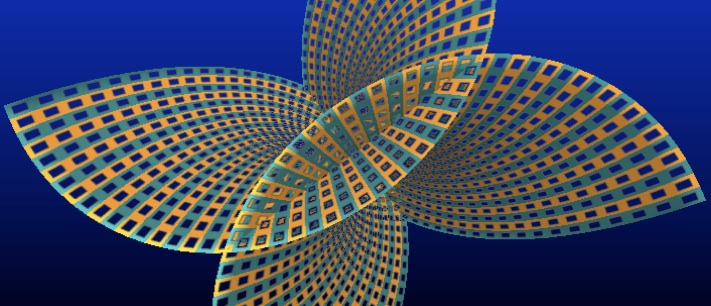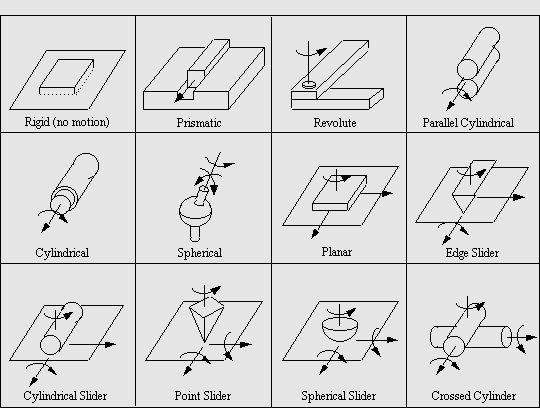Contact geometry
The mathematical field of contact geometry is a branch of differential geometry, which deals with certain geometric structures on differentiable manifolds, namely with completely non- integrable fields of hyperplanes in the tangent bundle, the so-called contact structures. The geometric idea thus described is quite simple: For each point of the manifold, a plane is selected, with an additional condition excludes the special case that the planes in layers, as shown in the second image.
Has its origins contact geometry, among others in geometrical optics and thermodynamics. The Norwegian mathematician Sophus Lie has late 19th century, described in detail the so-called contact transformations, to study, among other methods, such as differential equations and the Legendre transformation and canonical transformation of classical mechanics. Contact transformations were eponymous for the area; in today's language they are images of what contact structures, and hot Kontaktomorphismen.
Today, contact structures are studied because of their diverse topological properties and their numerous connections with other branches of mathematics and physics, such as the symplectic and complex geometry, the theory of foliations of codimension, dynamic systems and knot theory. Is particularly close relationship to symplectic geometry, because in many ways, contact structures that exist in odd dimensions, counterparts to the symplectic structures in even dimension.
- 3.1 Dimension 1
- 3.2 Dimension 3
- 3.3 dimension 2n 1
- 8.1 " Tight" vs. " overtwisted "
- 8.2 Open Books
Geometric idea
The accompanying pictures show parts of ebony distributions is on, which means that per point in three-dimensional space, a layer is selected from each of which a small piece was drawn. In the picture below the selected layers to fit together so that they can be interpreted as everywhere tangent to a foliation; Such distributions are called integrable. In the picture above, however, this is not the case, and that even in any single point. A plane distribution with this property is called completely non- integrable or non- integrable maximum and defines a contact structure.
In fact, every contact structure on a small scale looks something like the one shown in the picture; this is the statement of the theorem of Darboux shown below. Therefore, the contact geometry, the question arises as contact structures may be different on different manifolds in the large and what properties they have.
Definitions
A contact structure on a manifold M is ξ given by a field of hyperplanes, ie, for each point p of M, the indication of a hyperplane in the tangent space TpM, this field must be completely non- integrable. The Frobenius theorem states when a plane distribution as ξ integrable, a contact structure is thus a plane distribution that satisfies the conditions at any point of this set.
Often it is more convenient to work not directly related to contact structures but with contact forms. A contact form is a differentiable 1-form α on a ( 2n 1 )-dimensional manifold M, which is degenerate in the following sense anywhere:
In which
That is, a volume shape.
A contact form uniquely defines a contact structure. The core of ξ α is a hyperplane field and the above condition caused by the theorem of Frobenius that ξ is a contact structure: This field is completely non- integrable.
Conversely, again according to the Frobenius theorem, an integrable plane field ( a differential form closed α is, if ) can be locally as the core of a closed describe 1-form, however, is a contact structure a level field, which can be described locally as the core of a contact form.
Equivalent to the condition from above you can see the non- degeneracy of α thus demand that a symplectic form should be on the hyperplane field.
Naming Conventions
A manifold M with contact structure ξ is called contact manifold (M, ξ ). A diffeomorphism between contact manifolds, which is compatible with the particular structures, called a Kontaktomorphismus, originally in Lie contact transformation. The two contact manifolds are then called kontaktomorph.
Examples
Dimension 1
In dimension 1, the contact forms are exactly the same with the volume forms, the contact structures are therefore trivial.
Dimension 3
As a basic example of a contact structure is considered, with the coordinates and the 1-form
The contact plane ξ at a point is determined by the vectors
And
Spanned. This contact structure is shown at the very top of the article.
In the picture on the right is the contact structure
Shown with cylindrical coordinates are.
Dimension 2n 1
The basic example can be the standard contact form to generalize on, equipped with the coordinates that define the two - forms
And
Two mutually kontaktomorphe contact structures.
Reeb vector fields
A contact form contains more information than a contact structure, among other things, it also defines a Reeb vector field. This vector field is defined for each point by the unique vector R such that and.
The Weinstein conjecture states that every Reeb vector field has closed orbits.
Contact Geometry and Symplectic Geometry
Let be a symplectic manifold with convex boundary, in a neighborhood of. Then defined on a contact structure. We say that the contact manifold is symplectic fillable (English: symplectically fillable ).
A Liouville field is a symplectic filling, in which all defined on.
A weak symplectic filling of a contact manifold is a symplectic manifold with conformally equivalent to. In dimensions every weakly fillable Kontakstruktur is also symplectic be filled, so a weaker notion of weak filling ability is considered in these dimensions: is a weak filling of if for all is.
Legendre submanifolds
The most interesting submanifolds of a contact manifold (M, ξ ) are their Legendre submanifolds. The non- integrability of the contact hyperplane field on a ( 2n 1) - dimensional manifold means that no 2n- dimensional submanifold has this field as tangent bundle, not even locally. However, let n- dimensional ( embedded or always ized ) submanifolds L, see whose tangent spaces are in the contact field, ie
One can show that those so-called isotropic submanifolds achieve maximum dimension n. A submanifold of maximal dimension is called a Legendre submanifold. Two such submanifolds are called equivalent if they can be joined by a family of Kontaktomorphismen the surrounding manifold, starting from the identity.
Considering contact manifolds of dimension three, then form the associated compact Legendre submanifolds nodes that are called Legendre nodes. Each node in with its standard contact structure (see the example above) can be realized as a Legendre nodes. Sometimes this can be done in several ways: inequivalent Legendre nodes can be as ordinary nodes are equivalent.
From the symplectic field theory of invariants of Legendre submanifolds can be obtained, called relative contact homology, which can distinguish different Legendre submanifolds sometimes, which are topologically identical.
The set of Darboux
The set of Darboux is a fundamental result of the contact geometry as well as the more famous symplectic geometry. It is named after Jean Gaston Darboux, the problem was solved so that the Pfaffian ( after Johann Friedrich Pfaff ). One of the consequences of the theorem is that any two contact manifolds of the same dimension are always local kontaktomorph. There is thus for each point p of a neighborhood U M which contains P and local coordinates on the U, in which the contact structure having the above- mentioned standard form.
In comparison with the Riemannian geometry, this is a stark contrast: Riemannian manifolds have interesting local properties such as curvature. In contrast, there is a small scale only a single model of contact manifolds. For example, the two contact structures are described and illustrated on locally kontaktomorph and can therefore (cum grano salis ) both standard contact structure are called on.
3-dimensional contact geometry
"Tight " vs. " overtwisted "
In the 3- dimensional contact geometry, there is the dichotomy between tight (English: tight ) and overwound (English: overtwisted ) contact structures. A contact structure is called overexcited when there is an " over-excited " circular disc ( ie the induced foliation of a singularity inside and otherwise running of the singularity at the boundary of the disk orbits has ). The Kontaktsruktur is called tight, if there is no over-excited circular disk.
If a contact structure (weak) is symplectic fillable, then it is taut. The inclusions
3 inclusions in real dimension. Besides overwound circular disks, the non - vanishing of the Giroux torsion is another obstacle to symplectic filling ability. Giroux the twist is defined as the maximum, for the embedding of in exist.
For overwound contact structures is considered an h - principle, their classification up to homotopy is equivalent to the classification of the level fields up to homotopy.
Open Books
Set of Giroux: On orientable 3-manifolds, there is a bijection between the set of the contact structures up to isotopy and the amount of open-book up to positive stabilization.
Set of Boothby - Wang
A contact manifold is called regular if every point has a neighborhood undergoes at most once by each integral curve of the Reeb vector field.
The set of Boothby - Wang characterizes compact regular contact manifolds: these are exactly the bundles on symplectic manifolds whose symplectic form defines an integral cohomology class.
Furthermore, there is in this case a zero the function so that the Reeb vector field generated at the effect and it applies.










